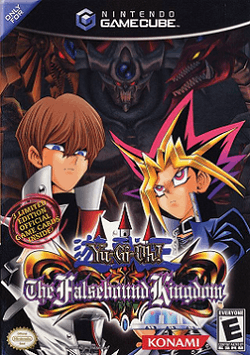Yu-Gi-Oh! The Falsebound Kingdom
| Yu-Gi-Oh! The Falsebound Kingdom | |
|---|---|
 North American cover art | |
| Developer(s) | Konami |
| Publisher(s) | Konami |
| Series | Yu-Gi-Oh! |
| Platform(s) | GameCube |
| Release date(s) |
‹See Tfd› |
| Genre(s) | Real-time strategy |
Yu-Gi-Oh! The Falsebound Kingdom (遊戯王 フォルスバウンドキングダム ~虚構に閉ざされた王国 Yugiō forusubaundo kingudamu ~ kyokō ni tozasa reta ōkoku) is the only Nintendo GameCube game in the Yu-Gi-Oh! series.
Yu-Gi-Oh! Falsebound Kingdom takes a different direction from the rest of the series, being more of a mix of real-time strategy and role-playing video game elements than the typical card battling games seen on other systems.The gameplay features a 3D battle stage including bonuses and improvements (such as fortresses, weapons, etc.)
It features most of the major characters from the anime and manga series as well as 177 monsters.
Plot
At first the player can choose between two storylines, for Yugi Muto and Seto Kaiba, but later the player can get one for Joey Wheeler as well. The Yugi storyline involves Yugi, Joey, Tristan, and Téa being invited to the testing of the virtual reality game "Kingdom," created by the company SIC. When they enter the game they soon find themselves trapped within it, and they must summon the help of the game's characters and monsters in order to defeat the game's villain, Emperor Heishin, and ultimately stop the plans of the game's designer, Scott Irvine, to control the three Egyptian God cards. Along the way, the players faces Joey, Tea, Bakura, and Dark Bakura.
Kaiba's storyline features Seto Kaiba and his brother Mokuba Kaiba, who are also trapped in the game. Initially they work for Emperor Heishin, but Marthis, Kaiba's 'helper', hears Kaiba talking to Pegasus, and suspects that Kaiba is a spy for the resistance. Marthis turns Kaiba in to the Emperor, who sentences him to a public execution. However, Kaiba escapes with Mokuba and Bonz. Marthis is waiting for him with a unit, and promises the man who brings Kaiba to him anything he wants. After defeating all enemies on the level, Pegasus arrives and asks Kaiba to lead the resistance, as he 'cannot return to the Empire' with a price on his head. Kaiba recruits further members for his resistance, including Weevil Underwood and Rex Raptor.
A climactic plot event in both stories occurs when Mokuba is kidnapped, and Scott forces Kaiba to battle against Yugi. At the end of both storylines is a segment taking place within a secret room leading from the game's fantasy environment to the inner workings of the computer that is running the game itself. Either team must defeat Scott Irvine as well as the enemy DarkNite, wielder of one of the God Cards, Obelisk the Tormentor in Yugi's story, and Slifer the Sky Dragon in Kaiba's. After beating one story, the other storyline becomes harder, with higher level monsters. In this harder mode, there is an additional villain, Nitemare, who has the God Card at level 99.
Joey's storyline is a prequel to Yugi's and features some minor characters from the other storylines. Its main villain is Marik Ishtar who uses The Winged Dragon of Ra. This storyline finishes with the character facing Kaiba, Mokuba, Marthis, and other Marshals.
Gameplay
Challenge Mode
The game also includes a Challenge Mode consisting entirely of battles, where the player has to fight various characters from the campaign, such as Joey, Kaiba, and Yugi.
Reception
| Reception | ||||||||||||||||||||||||
|---|---|---|---|---|---|---|---|---|---|---|---|---|---|---|---|---|---|---|---|---|---|---|---|---|
| ||||||||||||||||||||||||
The game received "generally unfavorable reviews" according to video game review aggregator Metacritic.[1]
References
- 1 2 "Yu-Gi-Oh! The Falsebound Kingdom for GameCube Reviews". Metacritic. Retrieved October 7, 2015.
- ↑ Kato, Matthew (January 2004). "Yu-Gi-Oh! The Falsebound Kingdom". Game Informer (129): 141. Archived from the original on April 18, 2009. Retrieved October 7, 2015.
- ↑ DJ Dinobot (December 3, 2003). "Yu-Gi-Oh The Falsebound Kingdom Review for GameCube on GamePro.com". GamePro. Archived from the original on December 13, 2004. Retrieved October 7, 2015.
- ↑ Davis, Ryan (January 13, 2004). "Yu-Gi-Oh! The Falsebound Kingdom Review". GameSpot. Retrieved October 7, 2015.
- ↑ Steinberg, Steve (December 6, 2003). "GameSpy: Yu-Gi-Oh!: The Falsebound Kingdom". GameSpy. Archived from the original on December 3, 2005. Retrieved October 7, 2015.
- ↑ Tha Wiz (November 24, 2003). "Yu-Gi-Oh! The Falsebound Kingdom Review - GameCube". GameZone. Archived from the original on April 17, 2009. Retrieved October 7, 2015.
- ↑ Irwin, Mary Jane (November 14, 2003). "Yu-Gi-Oh! The Falsebound Kingdom". IGN. Retrieved October 7, 2015.
- ↑ "Yu-Gi-Oh! The Falsebound Kingdom". Nintendo Power. 174: 146. December 2003.